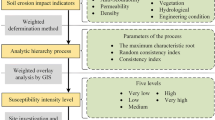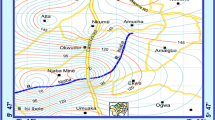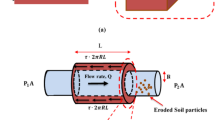Abstract
Cutoff wall has been widely used as a barrier to prevent the migration of contaminants in aquifers. Hydraulic impermeability and homogeneity should be ensured before operation. The difficulties in the rapid evaluation of newly constructed cutoff wall lie in high-quality sampling and time-consuming laboratory testing. In this study, piezocone penetration test is used to evaluate the barrier performance of a newly built cutoff wall. A Bayesian approach combined with genetic algorithm is adopted. The weak layers of cutoff wall are identified using excess pore water pressure data. The causes of impermeability defect are quantitatively characterized through optimized model parameters. Then, through comparison with the results of traditional soil behavior type based classification method, it points out the inapplicability of traditional method to evaluate the goodness of cutoff wall. Finally, the continuous horizontal hydraulic permeability profile is assessed by combining pore water pressure dissipation tests with adopted Bayesian approach. Results show that adopted Bayesian approach using excess pore water pressure can properly identify the weak layers of the newly built cutoff wall and reflect the causes. The analysis results can be used as guiding information for making remediation plans.












Similar content being viewed by others
Abbreviations
- k :
-
Hydraulic permeability
- TRD:
-
Trench cutting and re-mixing deep wall
- QC/QA:
-
Quality control/quality assurance
- CPTU:
-
Piezocone penetration test
- q t :
-
Cone tip resistance
- f s :
-
Sleeve friction
- u 2 :
-
Pore water pressure at the cone shoulder
- k h :
-
Horizontal hydraulic permeability
- GGBS:
-
Ground granulated blast-furnace slag
- XRF:
-
X-ray fluorescence
- K D :
-
Dimensionless hydraulic conductivity index
- r :
-
Cone radius
- γ w :
-
Unit weight of water
- U :
-
Cone penetration rate
- σ ′ v0 :
-
Vertical effective stress
- B q :
-
Dimensionless pore water pressure ratio
- Q t :
-
Dimensionless tip resistance
- σ v0 :
-
Total vertical stress
- Δu :
-
Excess pore water pressure
- C :
-
Correlation coefficient between reciprocal of Δu and kh
- KS test:
-
Kolmogorov–Smirnov test
- H 0 :
-
Hypothesis
- D α :
-
The value under significance level of α, reject the H0
- n :
-
The number of the sample
- CDF:
-
Cumulative distribution function
- F n(x):
-
Empirical cumulative distribution function
- F(x):
-
Pre-specified theoretical CDF
- p :
-
The probability of observing a test statistic as extreme as, or more extreme than, the observed value under the H0 hypothesis
- h :
-
The hypothesis test result returned as logical value (1 or 0)
- N :
-
Number of soil layers
- h n :
-
Thickness of the nth layer
- a n :
-
Model parameter of the nth layer characterizes the influence of uneven mixing of backfill materials
- b :
-
Model parameter characterizes the influence of consolidation and ages
- σ n :
-
Model parameter of the nth layer characterizes the homogeneity
- θ n :
-
Vector of the model parameters
- Θ N :
-
[θ1, θ2, …, θn, …, θN]
- K N :
-
Normalizing constant
- P (Δu| Θ N, N):
-
The likelihood function
- P(Θ N|N):
-
Prior distribution
- M n :
-
The number of excess pore water pressure data within the nth layer
- P (Δu n , i |θ n, N):
-
Likelihood function for the ith Δun data
- D n , i :
-
Depth of the Δun,i data
- P (θ n |N):
-
Prior distribution of model parameter θn
- PDF:
-
Probability distribution function
- Θ N * :
-
Most probable model parameters for N
- SuS:
-
Subset simulation
- GA:
-
Genetic algorithm
- h N * :
-
Optimal layer thickness for N
- N * :
-
Optimal number of layers
- H(Θ N *):
-
Hessian matrix of N evaluated at ΘN*
- j N :
-
The number of model parameters for N
- −ln[P(Θ N|Δu, N)]:
-
Objective function
- SBT:
-
Soil behavior type
- I c :
-
Soil behavior type index
- Q tn :
-
Normalized cone tip resistance
- P a :
-
Atmosphere pressure
- c :
-
Stress exponent based on the soil behavior type
- F r :
-
Normalized friction ratio
- C–S–H:
-
Calcium silicate hydrate
- HT:
-
Hydrotalcite
- t 50 :
-
Time for 50% excess pore water pressure dissipation
- c h :
-
Horizontal coefficient of consolidation
- m v :
-
Coefficient of volume compressibility
- T * :
-
The time factor
- I r :
-
Rigidity index
- G :
-
Shear modulus
- s u :
-
Undrained shear strength
References
ASTM D5778 (2000) Standard Test Method for Electronic Friction Cone and Piezocone Penetration Testing of Soils. ASTM International, West Conshohocken
ASTM D2216 (2010a) Standard test methods for laboratory determination of water (moisture) content of soil and rock by mass. ASTM International, West Conshohocken
ASTM D4318 (2010b) Standard test methods for liquid limit, plastic limit, and plasticity index of soils. ASTM International, West Conshohocken
ASTM D7503 (2010c) Standard test method for measuring the exchange complex and cation exchange capacity of inorganic fine-grained soils. ASTM International, West Conshohocken
ASTM D4813 (2014) Standard test methods for specific gravity of soil solids by water pycnometer. ASTM International, West Conshohocken
ASTM D2487-17 (2017) Standard Practice for Classification of Soils for Engineering Purposes (Unified Soil Classification System). ASTM International, West Conshohocken
ASTM D4972 (2018) Standard test method for pH of soils. ASTM International, West Conshohocken
Bennert TA, Maher A, Jafari F (2005) Piezocone evaluation of a shallow soil-bentonite slurry wall. In: Waste containment and remediation, pp 1–14
Cao ZJ, Wang Y (2013) Bayesian approach for probabilistic site characterization using cone penetration tests. J Geotech Geoenviron Eng 139(2):267–276
Cao ZJ, Zheng S, Li DQ, Phoon KK (2019) Bayesian identification of soil stratigraphy based on soil behaviour type index. Can Geotech J 56(4):570–586
Cerato AB, Lutenegger AJ (2002) Determination of surface area of fine-grained soils by the ethylene glycol mo-noethyl ether (EGME) method. Geotech Test J 25(3):315–321. https://doi.org/10.1520/GTJ11087J
Chai JC, Agung PMA, Hino T, Igaya Y, Carter JP (2011) Estimating hydraulic conductivity from piezocone soundings. Géotechnique 61(8):699–708
Chai J, Chanmee N (2018) A modified method for estimating permeability of clayey soils based on piezocone sounding results. Can Geotech J 55(9):1268–1281
Ching J, Phoon KK, Chen YC (2010) Reducing shear strength uncertainties in clays by multivariate correlations. Can Geotech J 47(1):16–33
Christian JT, Baecher GB (2011) Unresolved problems in geotechnical risk and reliability. In: Geo-risk 2011: risk assessment and management, pp 50–63
Dagger R, Saftner D, Mayne P (2018) Cone penetration test design guide for state geotechnical engineers. Report No. 2018-32, Minnesota Dept. of Transportation, St. Paul, MN: 225 p. https://www.dot.state.mn.us/research/reports/2018/201832.pdf
Dimitrova DS, Kaishev VK, Tan S (2020) Computing the Kolmogorov-Smirnov distribution when the underlying CDF is purely discrete, mixed, or continuous. J Stat Softw 95(1):1–42
Du YJ, Fan RD, Liu SY, Reddy KR, ** F (2015) Workability, compressibility and hydraulic conductivity of zeolite-amended clayey soil/calcium-bentonite backfills for slurry-trench cutoff walls. Eng Geol 195:258–268
Du YJ, Wu J, Bo YL, Jiang NJ (2020) Effects of acid rain on physical, mechanical and chemical properties of GGBS–MgO-solidified/stabilized Pb-contaminated clayey soil. Acta Geotech 15(4):923–932
Elsworth D, Lee DS (2005) Permeability determination from on-the-fly piezocone sounding. J Geotech Geoenviron Eng 131(5):643–653
Fenton GA (1999) Random field modeling of CPT data. J Geotech Geoenviron Eng 125(6):486–498
Gilbert RB, Tang WH (1995) Model uncertainty in offshore geotechnical reliability. Proceeding of the 27th offshore technology conference. Society of Petroleum Engineers, Houston, pp 557–567
Gruskovnjak A, Lothenbach B, Winnefeld F, Figi R, Ko SC, Adler M, Mäder U (2008) Hydration mechanisms of super sulphated slag cement. Cement Concrete Res 38(7):983–992
Gull SF (1988) Bayesian inductive inference and maximum entropy. Maximum-entropy and Bayesian methods in science and engineering. Springer, Dordrecht, pp 53–74
Jefferies MG, Davies MP (1993) Use of CPTU to estimate equivalent SPT N 60. Geotech Test J 16(4):458–468. https://doi.org/10.1520/GTJ10286J
** F, Al-Tabbaa A (2014) Evaluation of novel reactive MgO activated slag binder for the immobilization of lead and zinc. Chemosphere 117:285–294. https://doi.org/10.1016/j.chemosphere.2014.07.027
** F, Gu K, Al-Tabbaa A (2015) Strength and hydration properties of reactive MgO-activated ground granulated blastfurnace slag paste. Cement Concrete Comp 57:8–16. https://doi.org/10.1016/j.cemconcomp.2014.10.007
** F, Wang F, Al-Tabbaa A (2016) Three-year performance of in-situ solidified/stabilised soil using novel MgO-bearing binders. Chemosphere 144:681–688. https://doi.org/10.1016/j.chemosphere.2015.09.046
Joshi K, Kechavarzi C, Sutherland K, Ng MYA, Soga K, Tedd P (2010) Laboratory and in situ tests for long-term hydraulic conductivity of a cement-bentonite cutoff wall. J Geotech Geoenviron Eng 136(4):562–572
Katsumi T, Kamon M, Inui T, Araki S (2008) Hydraulic barrier performance of SBM cut-off wall constructed by the trench cutting and re-mixing deep wall method. In: GeoCongress 2008: geotechnics of waste management and remediation, pp 628–635
Keramatikerman M, Chegenizadeh A, Nikraz H (2017) An investigation into effect of sawdust treatment on permeability and compressibility of soil-bentonite slurry cut-off wall. J Clean Prod 162:1–6
Li L, Li J, Sun DA, Gong W (2019) A feasible approach to predicting time-dependent bearing performance of jacked piles from CPTu measurements. Acta Geotech 15(7):1935–1952. https://doi.org/10.1007/s11440-019-00875-x
Li YC, Tong X, Chen Y, Ke H, Chen YM, Wen YD, Pan Q (2018) Non-monotonic piezocone dissipation curves of backfills in a soil-bentonite slurry trench cutoff wall. J Zhejiang Univ Sci A: Appl Phys Eng 19(4):277–288
Malusis MA, Barlow LC (2020) Comparison of laboratory and field measurements of backfill hydraulic conductivity for a large-scale soil-bentonite cutoff wall. J Geotech Geoenviron Eng 146(8):04020070
Malusis MA, Evans JC, Jacob RW, Ruffing D, Barlow L, Marchiori AM (2017) Construction and monitoring of an instrumented soil-bentonite cutoff wall: field research case study. In: Proceedings of the 29th Central Pennsylvania Geotechnical Conference, Hershey, PA, USA, pp 25–27
Manassero M (1994) Hydraulic conductivity assessment of slurry wall using piezocone test. J Geotech En 120(10):1725–1746
Monforte L, Arroyo M, Gens A, Carbonell JM (2018) Hydraulic conductivity from piezocone on-the-fly: a numerical evaluation. Géotechnique Lett 8(4):268–277
Najjar SS, Gilbert RB (2009) Importance of lower-bound capacities in the design of deep foundations. J Geotech Geoenviron Eng 135(7):890–900
Norris A, Di Emidio G, Malusis MA, Replogle M (2018) Modified bentonites for soil-bentonite cutoff wall applications with hard mix water. Appl Clay Sci 158:226–235
Robertson PK (1990) Soil classification using the cone penetration test. Can Geotech J 27(1):151–158. https://doi.org/10.1139/t90-014
Robertson PK (2010) Evaluation of flow liquefaction and liquefied strength using the cone penetration test. J Geotech Geoenviron Eng 136(6):842–853
Robertson PK, Wride CE (1998) Evaluating cyclic liquefaction potential using the cone penetration test. Can Geotech J 35(3):442–459. https://doi.org/10.1139/t98-017
Saka MP (2003) Optimum design of pitched roof steel frames with haunched rafters by genetic algorithm. Comput Struct 81(18–19):1967–1978
Shand MA (2006) The chemistry and technology of magnesia. Wiley, Hoboken
Takai A, Inui T, Katsumi T (2016) Evaluating the hydraulic barrier performance of soil-bentonite cutoff walls using the piezocone penetration test. Soils Found 56(2):277–290
Tedd P, Butcher AP, Powell JJM (1997) Assessment of the piezocone to measure the in-situ properties of cement-bentonite slurry trench cut-off walls. In: Geoenvironmental engineering: contaminated ground: fate of pollutants and remediation, Thomas Telford, London, pp 48–55
Teh CI, Houlsby GT (1991) An analytical study of the cone penetration test in clay. Géotechnique 41(1):17–34
Wang Y, Huang K, Cao Z (2013) Probabilistic identification of underground soil stratification using cone penetration tests. Can Geotech J 50(7):766–776
Wang Y, Huang K, Cao Z (2014) Bayesian identification of soil strata in London clay. Géotechnique 64(3):239–246
Wu SJ, Chow PT (1995) Steady-state genetic algorithms for discrete optimization of trusses. Comput Struct 56(6):979–991
Wu H, ** F, Bo Y, Du Y, Zheng J (2018) Leaching and microstructural properties of lead contaminated kaolin stabilized by GGBS-MgO in semi-dynamic leaching tests. Constr Build Mater 172:626–634. https://doi.org/10.1016/j.conbuildmat.2018.03.164
Wu HL, ** F, Zhou AN, Du YJ (2021) The engineering properties and reaction mechanism of MgO-activated slag cement-clayey sand-bentonite (MSB) cutoff wall backfills. Constr Build Mater 271:121890
Xu H, Zhu W, Qian X, Wang S, Fan X (2016) Studies on hydraulic conductivity and compressibility of backfills for soil-bentonite cutoff walls. Appl Clay Sci 132:326–335
Yang HQ, Zhang L, Pan Q, Phoon KK, Shen Z (2021) Bayesian estimation of spatially varying soil parameters with spatiotemporal monitoring data. Acta Geotech 16:263–278
Yi Y, Liska M, Al-Tabbaa A (2014) Properties of two model soils stabilized with different blends and contents of GGBS, MgO, lime, and PC. J Mater Civil Eng 26(2):267–274
Yi Y, Liska M, Al-Tabbaa A (2012) Initial investigation into the use of GGBS-MgO in soil stabilisation. In: Grouting and deep mixing, pp 444–453
Yin ZY, ** YF, Shen JS, Hicher PY (2018) Optimization techniques for identifying soil parameters in geotechnical engineering: comparative study and enhancement. Int J Numer Anal Methods 42(1):70–94
Zhang LM, Tang WH, Zhang LL, Zheng JG (2004) Reducing uncertainty of prediction from empirical correlations. J Geotech Geoenviron Eng 130(5):526–534
Zhang P, Yin ZY, ** YF, Liu XF (2021) Modelling the mechanical behaviour of soils using machine learning algorithms with explicit formulations. Acta Geotech. https://doi.org/10.1007/s11440-021-01170-4
Zhang J, Zhang LM, Tang WH (2009) Bayesian framework for characterizing geotechnical model uncertainty. J Geotech Geoenviron Eng 135(7):932–940
Zhao Z, Congress SSC, Cai G, Duan W (2021) Bayesian probabilistic characterization of consolidation behavior of clays using CPTU data. Acta Geotech. https://doi.org/10.1007/s11440-021-01277-8
Zou H, Liu S, Cai G, Puppala AJ (2020) Probabilistic identification of contaminated soils using resistivity piezocone penetration tests. Acta Geotech 15(3):761–779
Acknowledgements
The majority of the work presented in this paper is funded by the National Key R&D Program of China (Grant No. 2020YFC1807200) and the National Natural Science Foundation of China (Grant Nos. 41877231, 42072299).
Author information
Authors and Affiliations
Corresponding author
Additional information
Publisher's Note
Springer Nature remains neutral with regard to jurisdictional claims in published maps and institutional affiliations.
Rights and permissions
About this article
Cite this article
Wu, M., Cai, G., Liu, L. et al. Quantitative identification of cutoff wall construction defects using Bayesian approach based on excess pore water pressure. Acta Geotech. 17, 2553–2571 (2022). https://doi.org/10.1007/s11440-021-01414-3
Received:
Accepted:
Published:
Issue Date:
DOI: https://doi.org/10.1007/s11440-021-01414-3




